Typical values at 25°C, AIN
= -1 dBFS, FIN = 347 MHz, FS = 800 MSPS, High power mode, FG
calibration, JMODE 0, CPLL off, CPLLREF = 50 MHz and VA11Q and VCLK11
noise suppression on when CPLL on, nominal supply voltages, unless otherwise noted.
SNR results exclude DC, HD2 to HD9; SINAD, ENOB, and SFDR results exclude DC.
 Figure 5-1 DNL
vs Code
Figure 5-1 DNL
vs Code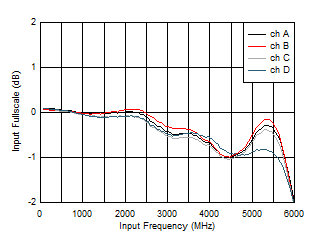 Figure 5-3 Input
Fullscale vs Input Frequency
Figure 5-3 Input
Fullscale vs Input Frequency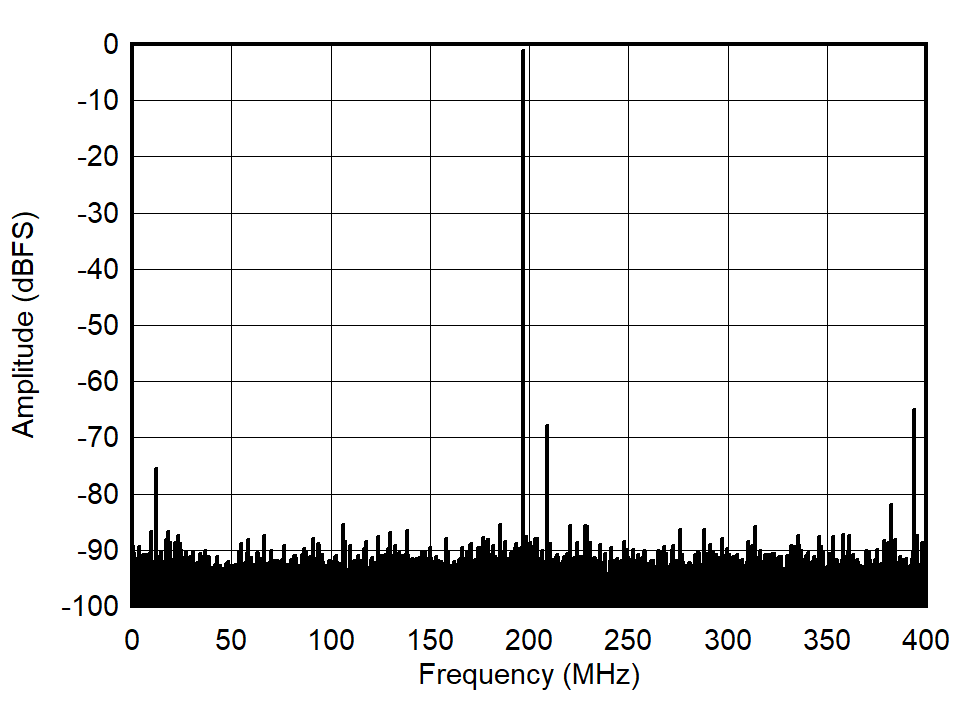 Figure 5-5 Single Tone FFT at 997 MHz and -1dBFS
Figure 5-5 Single Tone FFT at 997 MHz and -1dBFS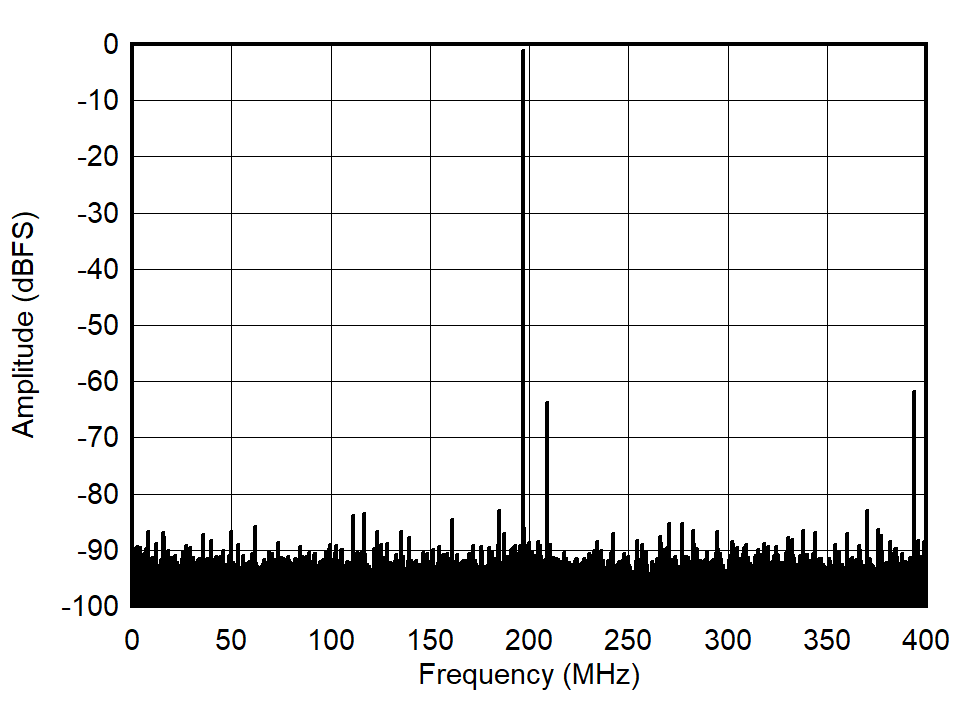 Figure 5-7 Single Tone FFT at 1797 MHz and -1dBFS
Figure 5-7 Single Tone FFT at 1797 MHz and -1dBFS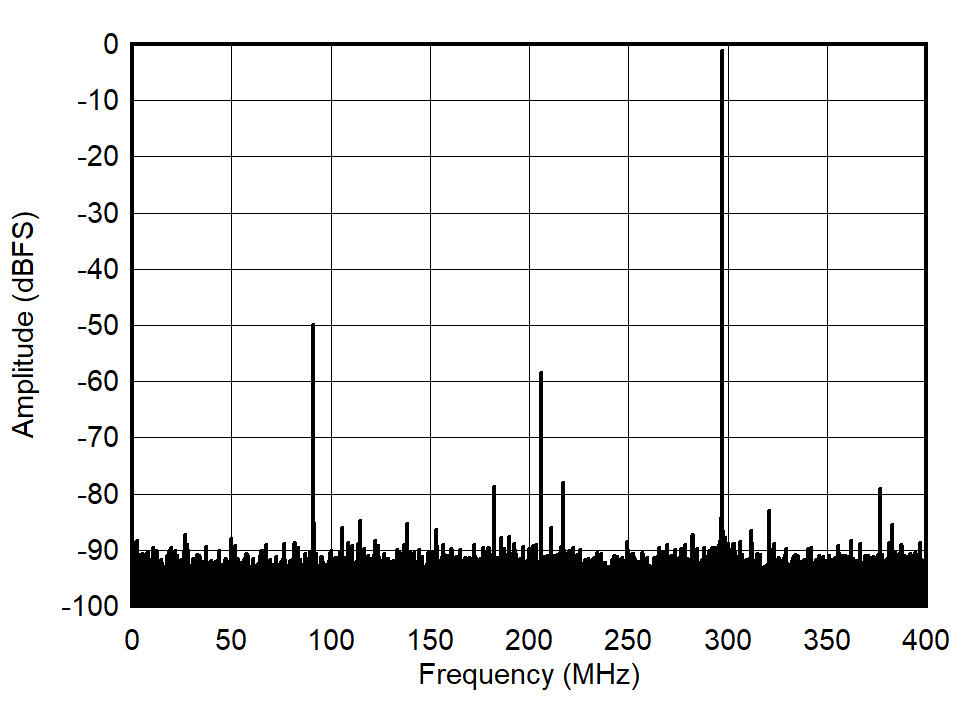 Figure 5-9 Single Tone FFT at 3497 MHz and -1dBFS
Figure 5-9 Single Tone FFT at 3497 MHz and -1dBFS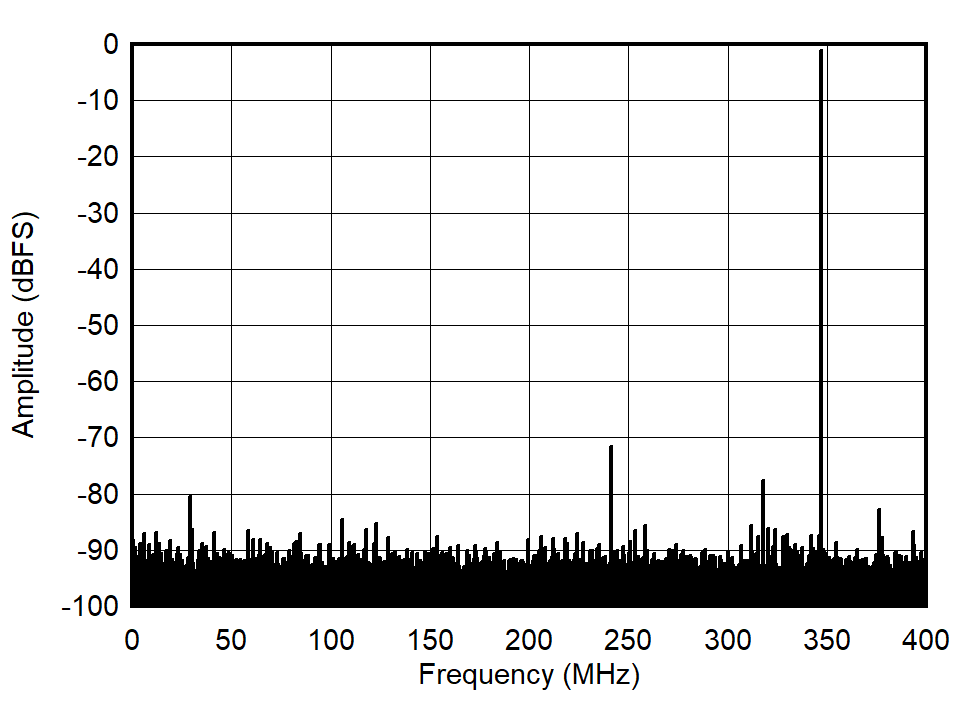 Figure 5-11 Single Tone FFT at 347MHz and -1dBFS
Figure 5-11 Single Tone FFT at 347MHz and -1dBFS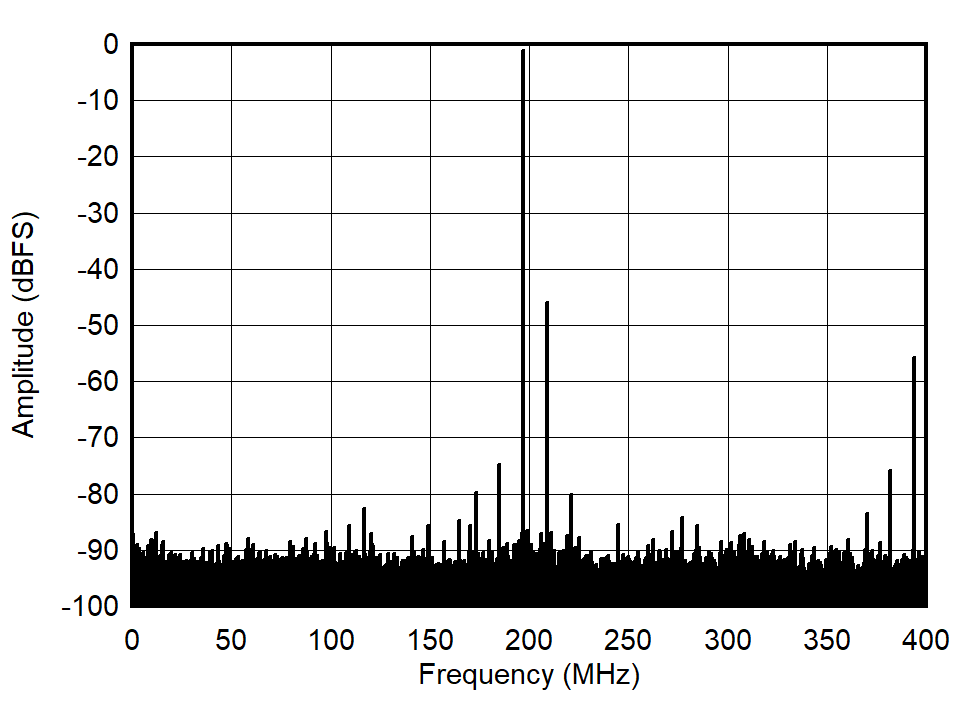 Figure 5-13 Single Tone FFT at 1797MHz and -1dBFS
Figure 5-13 Single Tone FFT at 1797MHz and -1dBFS Figure 5-15 SNR
vs Input Frequency
Figure 5-15 SNR
vs Input Frequency Figure 5-17 ENOB
vs Input Frequency
Figure 5-17 ENOB
vs Input Frequency Figure 5-19 HD3
vs Input Frequency
Figure 5-19 HD3
vs Input Frequency Figure 5-21 SNR
vs Sample Rate
Figure 5-21 SNR
vs Sample Rate Figure 5-23 ENOB
vs Sample Rate
Figure 5-23 ENOB
vs Sample Rate Figure 5-25 SNR
vs Sample Rate
Figure 5-25 SNR
vs Sample Rate Figure 5-27 ENOB
vs Sample Rate
Figure 5-27 ENOB
vs Sample Rate Figure 5-29 SNR
vs Input Amplitude
Figure 5-29 SNR
vs Input Amplitude Figure 5-31 SNR
vs Input Amplitude
Figure 5-31 SNR
vs Input Amplitude Figure 5-33 SFDR
vs Clock Amplitude
Figure 5-33 SFDR
vs Clock Amplitude Figure 5-35 SFDR
vs Temperature
Figure 5-35 SFDR
vs Temperature Figure 5-37 HD2
vs Temperature
Figure 5-37 HD2
vs Temperature Figure 5-39 Worst
non-HD2/3 Spur vs Temperature
Figure 5-39 Worst
non-HD2/3 Spur vs Temperature
| Low
Power Mode, FIN = 347MHz |
Figure 5-41 SFDR
vs Temperature
| Low
Power Mode, FIN = 347MHz |
Figure 5-43 HD2
vs Temperature
| Low
Power Mode, FIN = 347MHz |
Figure 5-45 Worst
non-HD2/3 Spur vs Temperature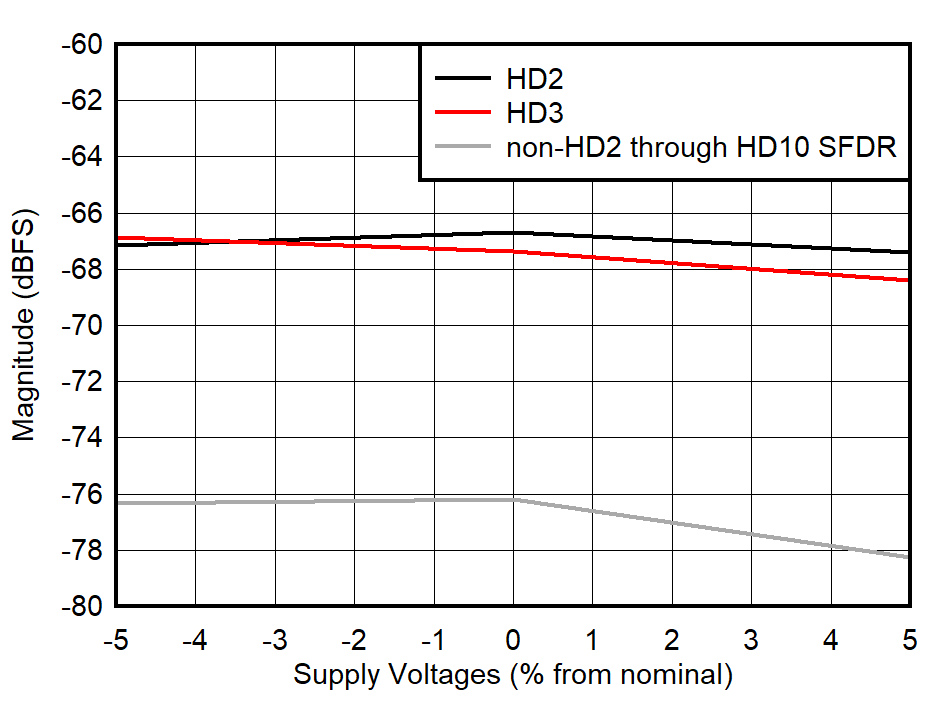 Figure 5-47 HD2,
HD3 and Worst non-HD2/3 Spur vs Supply Voltage
Figure 5-47 HD2,
HD3 and Worst non-HD2/3 Spur vs Supply Voltage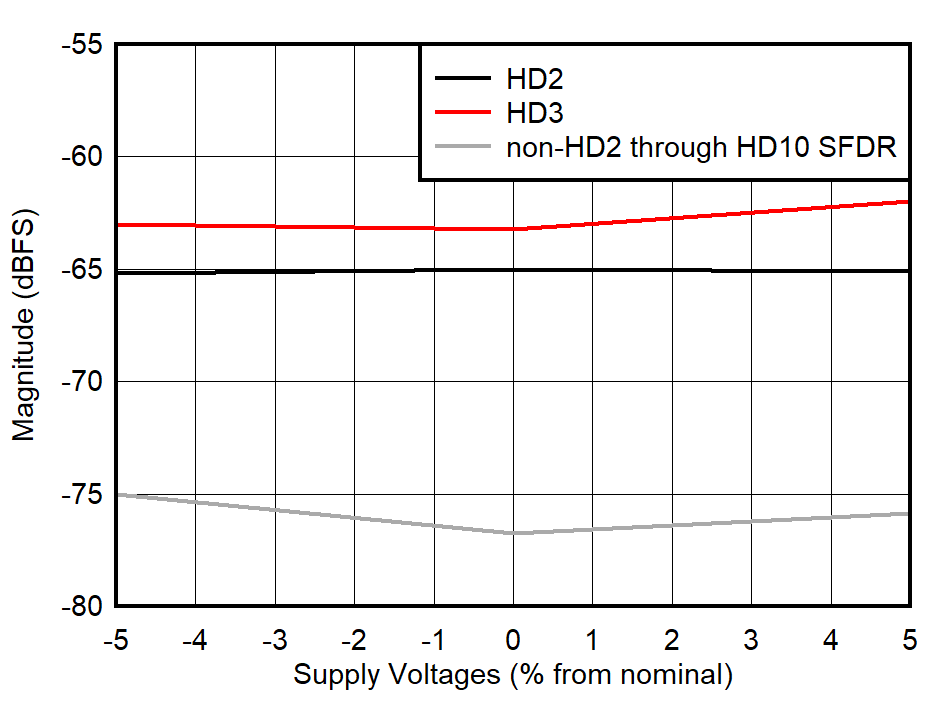
| Low
Power Mode, FIN = 347MHz |
Figure 5-49 HD2,
HD3 and Worst non-HD2/3 Spur vs Supply Voltage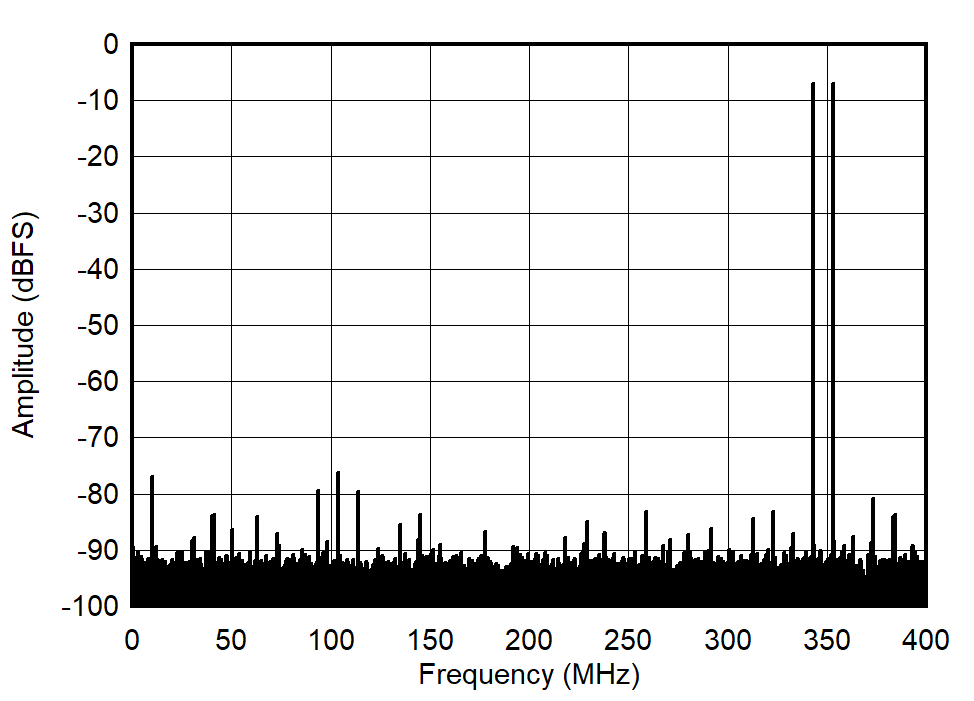 Figure 5-51 Single Tone FFT at 348 MHz
Figure 5-51 Single Tone FFT at 348 MHz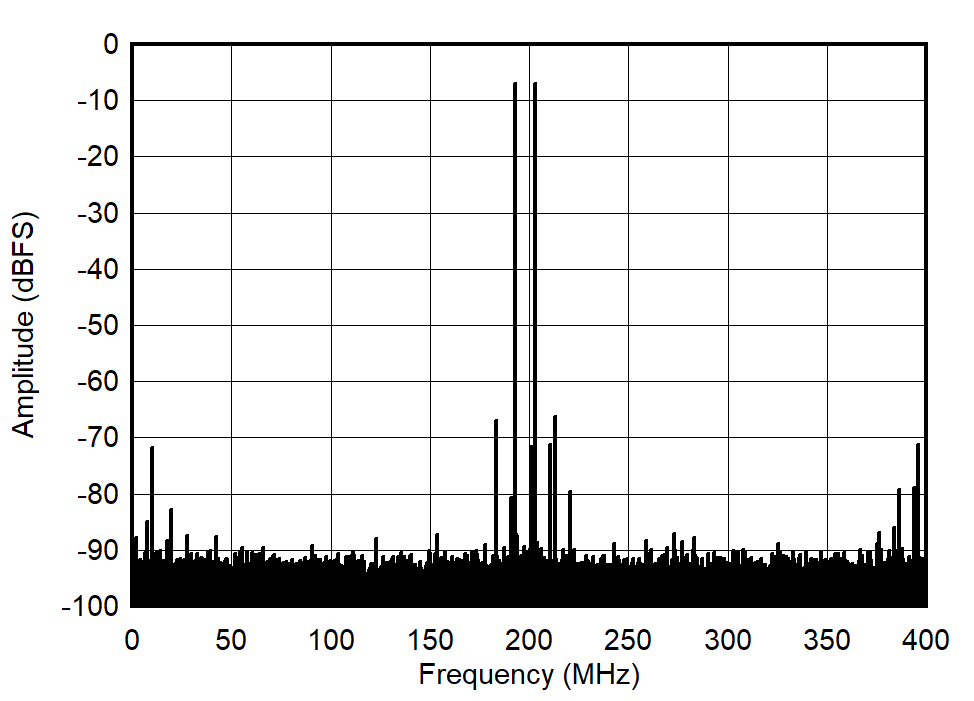 Figure 5-53 Single Tone FFT at 1798 MHz
Figure 5-53 Single Tone FFT at 1798 MHz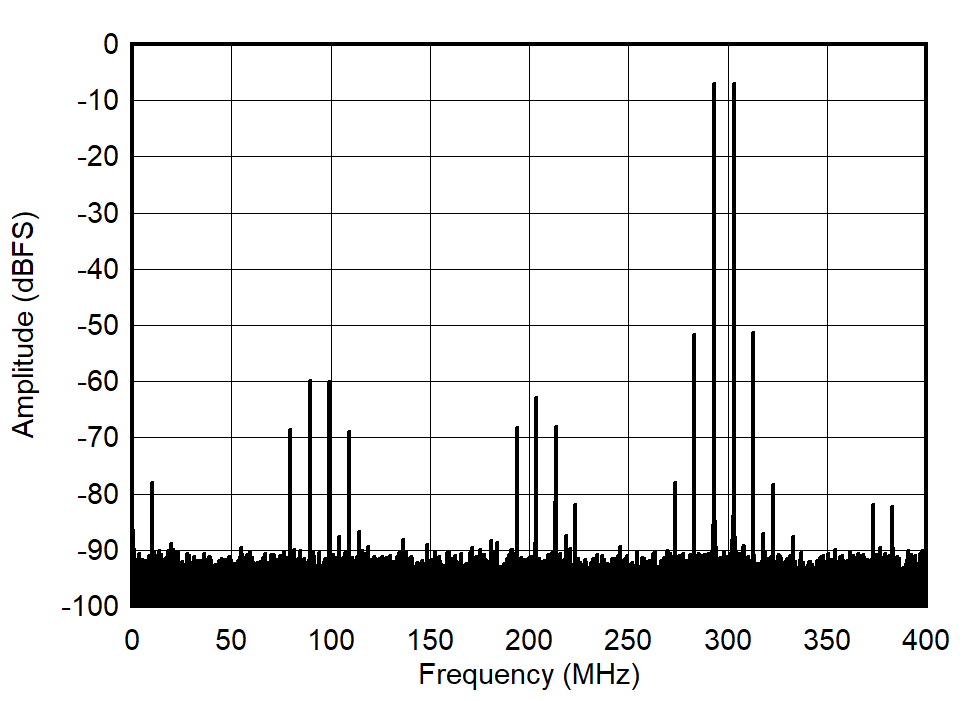 Figure 5-55 Single Tone FFT at 2698 MHz
Figure 5-55 Single Tone FFT at 2698 MHz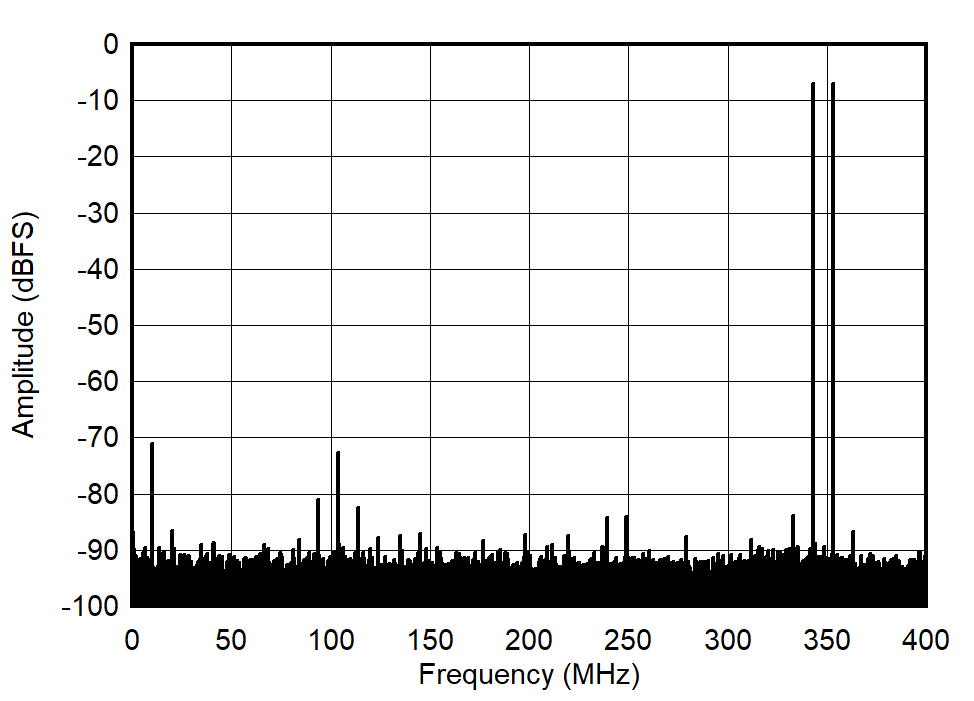
| Low
Power Mode, -7 dBFS each tone |
Figure 5-57 Single Tone FFT at 348 MHz (LP Mode) Figure 5-59 IMD3
vs Input Frequency
Figure 5-59 IMD3
vs Input Frequency Figure 5-61 Crosstalk vs Input Frequency
Figure 5-61 Crosstalk vs Input Frequency Figure 5-63 SNR
vs Reference Clock Frequency
Figure 5-63 SNR
vs Reference Clock Frequency Figure 5-65 SFDR
vs Input Frequency and CPLL and Power Mode
Figure 5-65 SFDR
vs Input Frequency and CPLL and Power Mode Figure 5-67 SINAD
vs Input Frequency and CPLL and Power Mode
Figure 5-67 SINAD
vs Input Frequency and CPLL and Power Mode Figure 5-69 HD2
vs Input Frequency and CPLL and Power Mode
Figure 5-69 HD2
vs Input Frequency and CPLL and Power Mode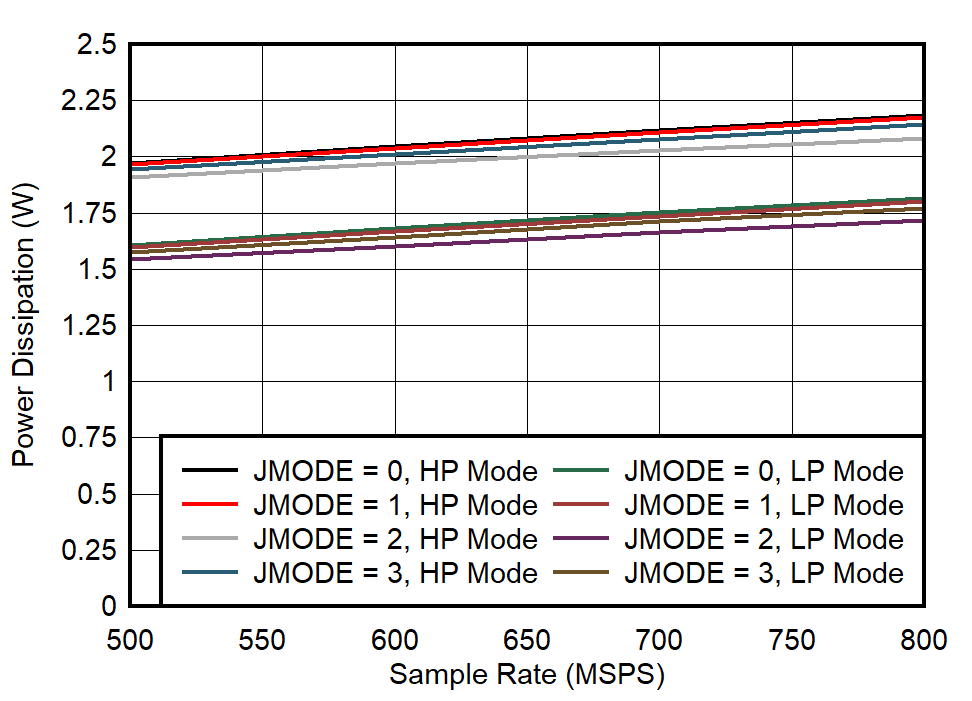 Figure 5-71 Quad
Channel, Power Dissipation vs FS for JMODES 0 - 3
Figure 5-71 Quad
Channel, Power Dissipation vs FS for JMODES 0 - 3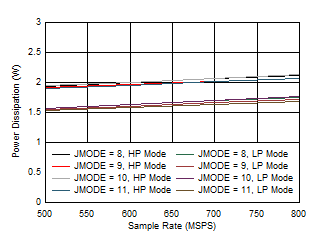 Figure 5-73 Quad
Channel, Power Dissipation vs FS for JMODES 8 - 11
Figure 5-73 Quad
Channel, Power Dissipation vs FS for JMODES 8 - 11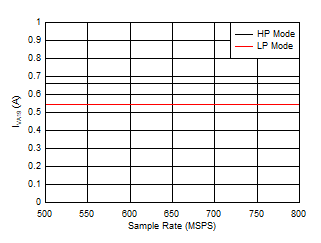 Figure 5-75 Quad
Channel, IVA19 vs FS
Figure 5-75 Quad
Channel, IVA19 vs FS
| Independent of Power Mode |
Figure 5-77 Quad
Channel, IVD11 vs FS for JMODES 0 - 3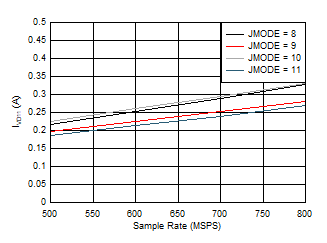
| Independent of Power Mode |
Figure 5-79 Quad
Channel, IVD11 vs FS for JMODES 8 - 11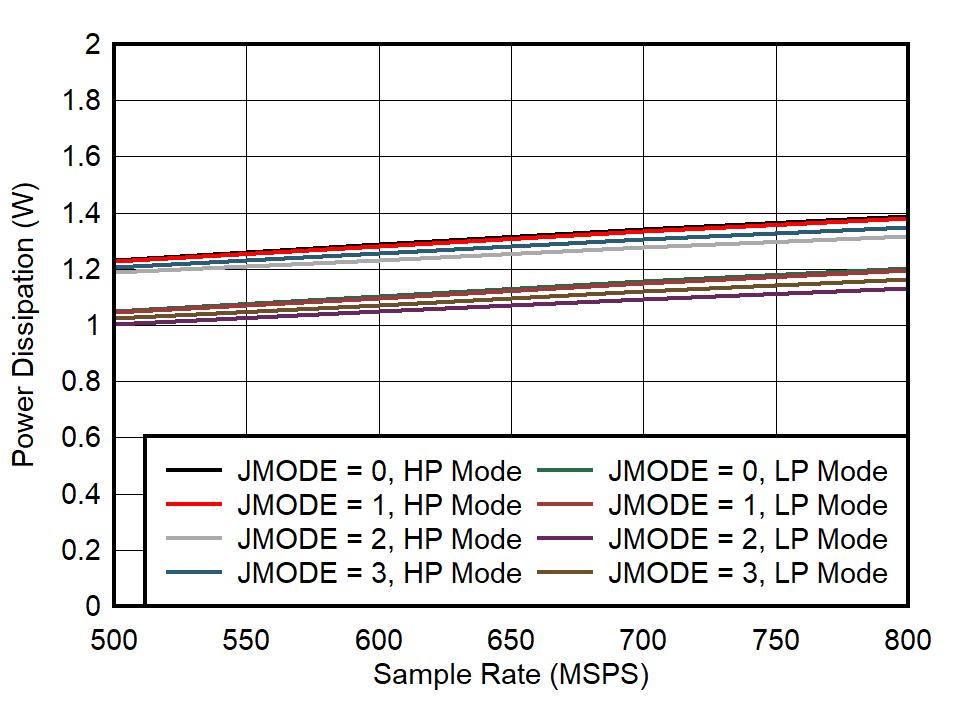 Figure 5-81 Dual
Channel, Power Dissipation vs FS for JMODES 0 - 3
Figure 5-81 Dual
Channel, Power Dissipation vs FS for JMODES 0 - 3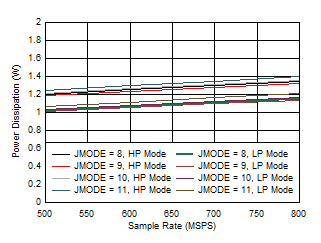 Figure 5-83 Dual
Channel, Power Dissipation vs FS for JMODES 8 - 11
Figure 5-83 Dual
Channel, Power Dissipation vs FS for JMODES 8 - 11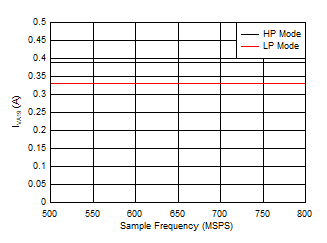 Figure 5-85 Dual
Channel, IVA19 vs FS
Figure 5-85 Dual
Channel, IVA19 vs FS
| Independent of Power Mode |
Figure 5-87 Dual
Channel, IVD11 vs FS for JMODES 0 - 3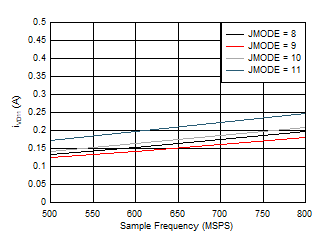
| Independent of Power Mode |
Figure 5-89 Dual
Channel, IVD11 vs FS for JMODES 8 - 11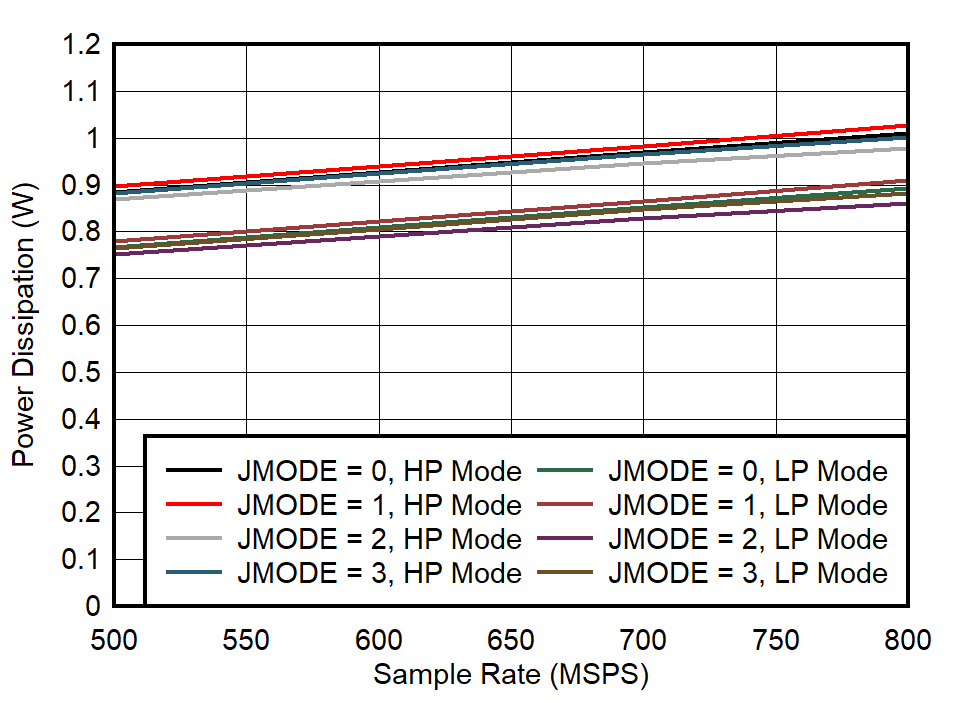 Figure 5-91 Single Channel, Power Dissipation vs FS for JMODES 0 - 3
Figure 5-91 Single Channel, Power Dissipation vs FS for JMODES 0 - 3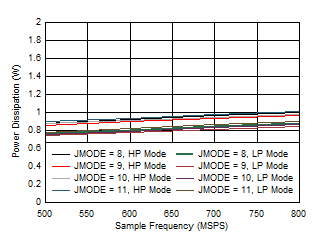 Figure 5-93 Single Channel, Power Dissipation vs FS for JMODES 8 -
11
Figure 5-93 Single Channel, Power Dissipation vs FS for JMODES 8 -
11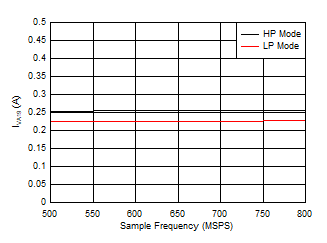 Figure 5-95 Single Channel, IVA19 vs FS
Figure 5-95 Single Channel, IVA19 vs FS
| Independent of Power Mode |
Figure 5-97 Single Channel, IVD11 vs FS for JMODES 0 - 3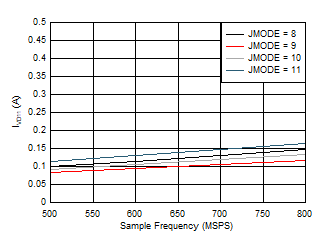
| Independent of Power Mode |
Figure 5-99 Single Channel, IVD11 vs FS for JMODES 8 - 11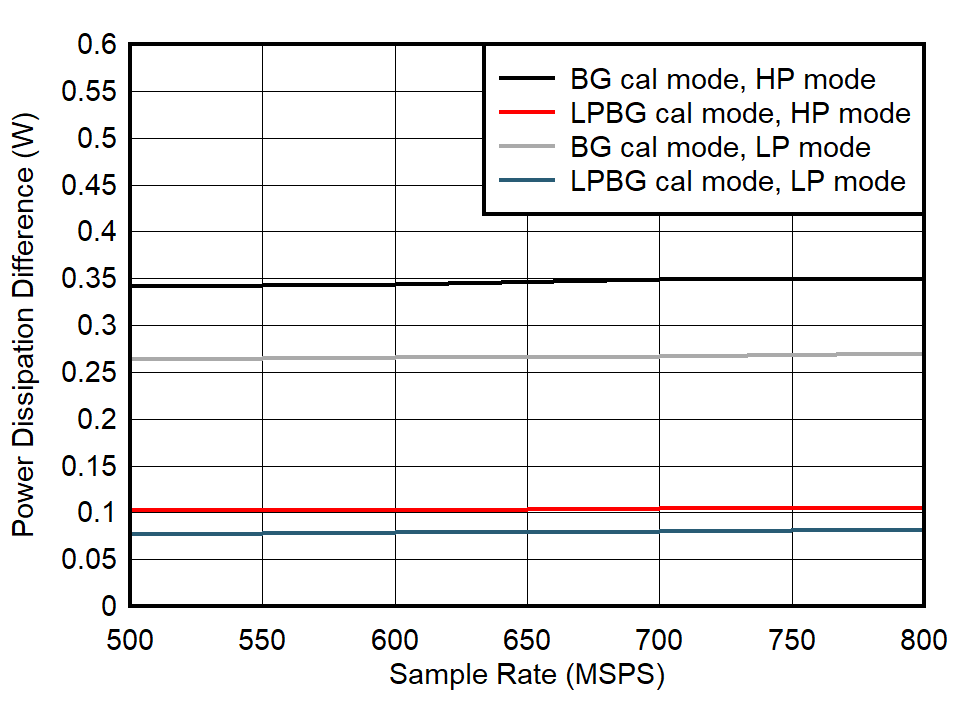
| Independent of Power Mode |
Figure 5-101 Quad
Channel, Power Dissipation Change with Calibration Mode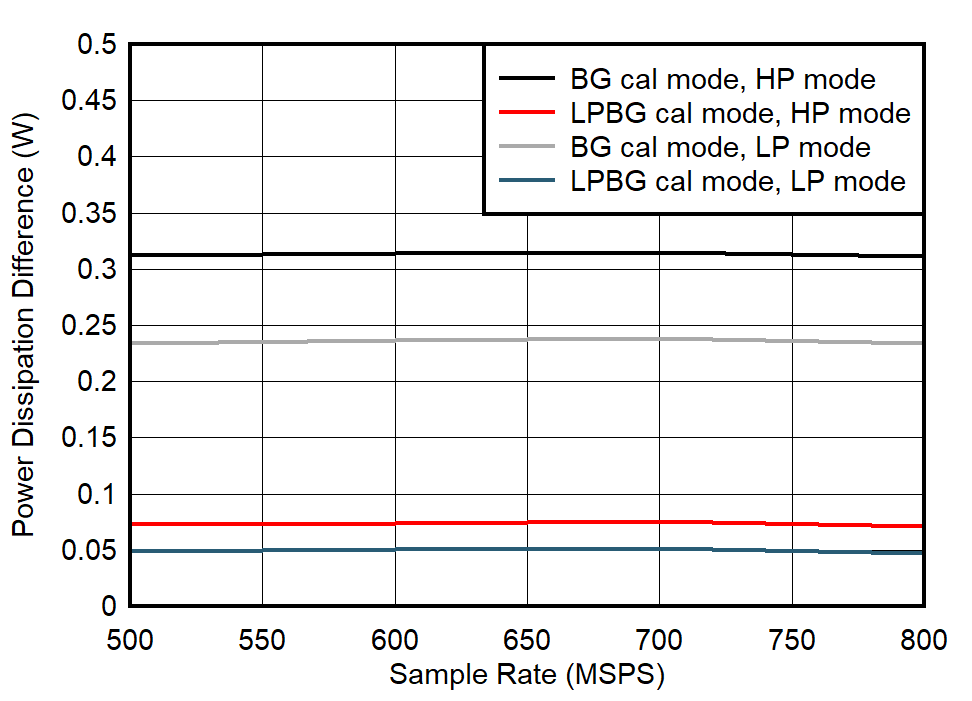
| Independent of Power Mode |
Figure 5-103 Single Channel, Power Dissipation Change with Calibration Mode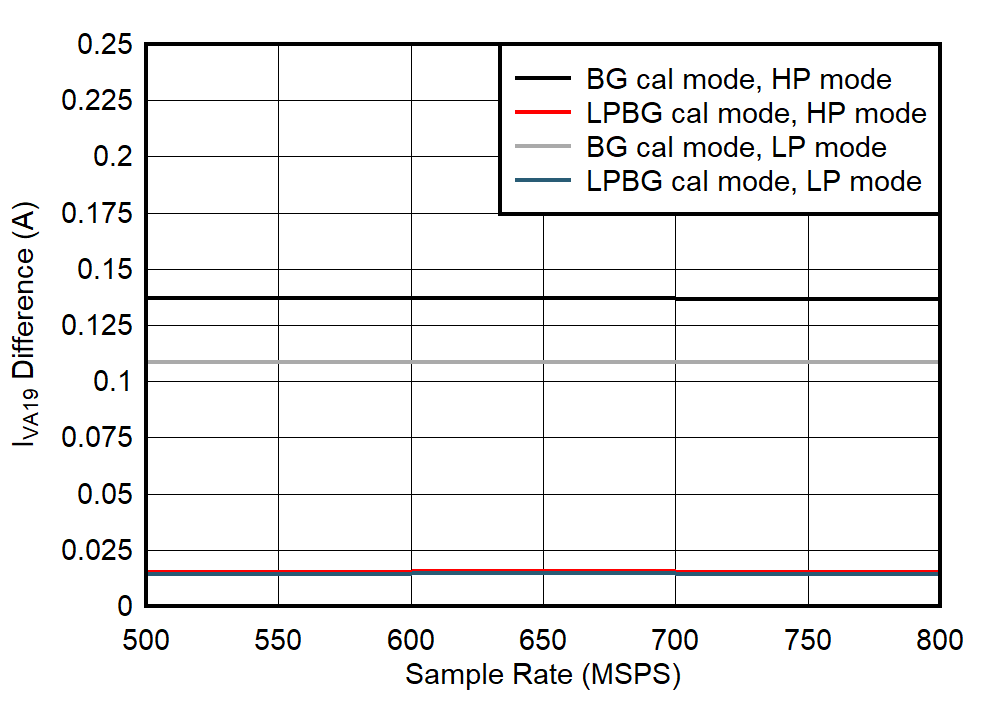
| Independent of Power Mode |
Figure 5-105 Dual
Channel, IVA19 Change with Calibration Mode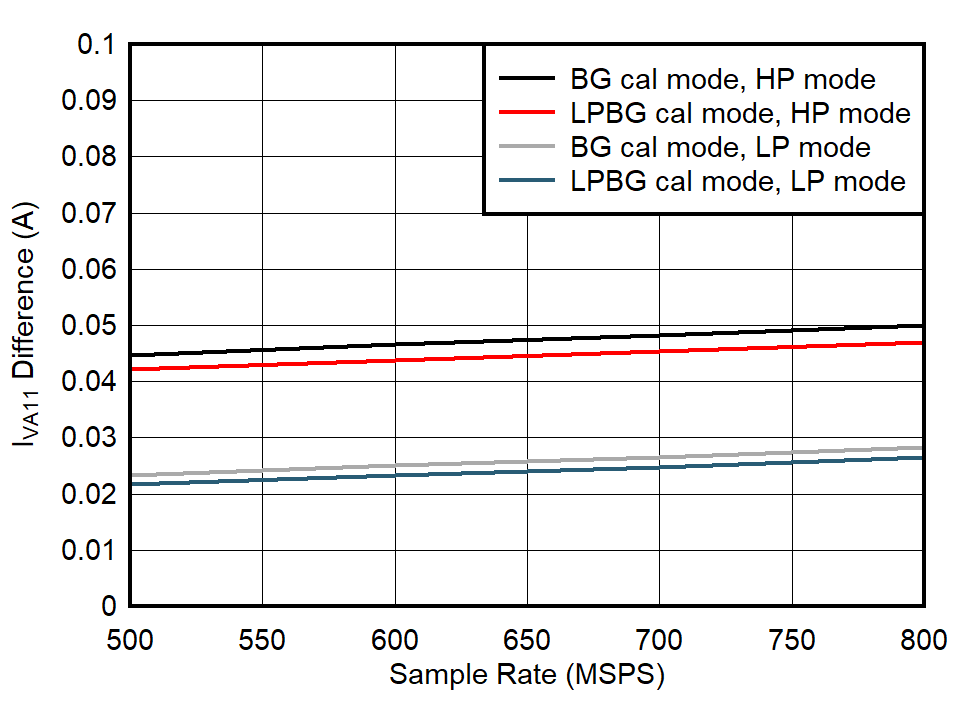
| Independent of Power Mode |
Figure 5-107 Quad
Channel, IVA11 Change with Calibration Mode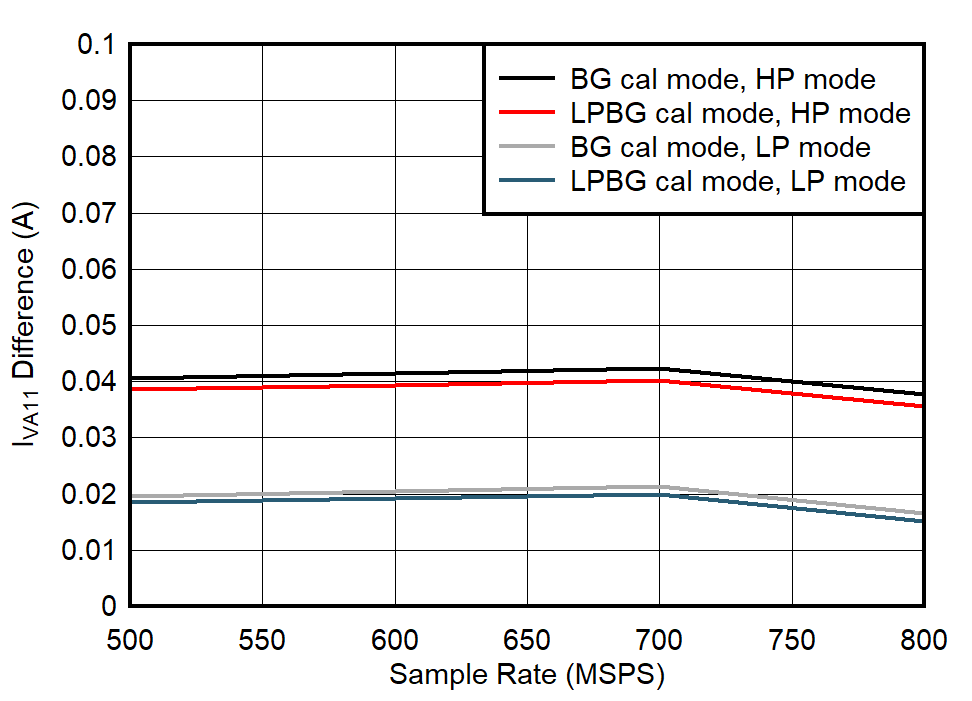
| Independent of Power Mode |
Figure 5-109 Single Channel, IVA11 Change with Calibration Mode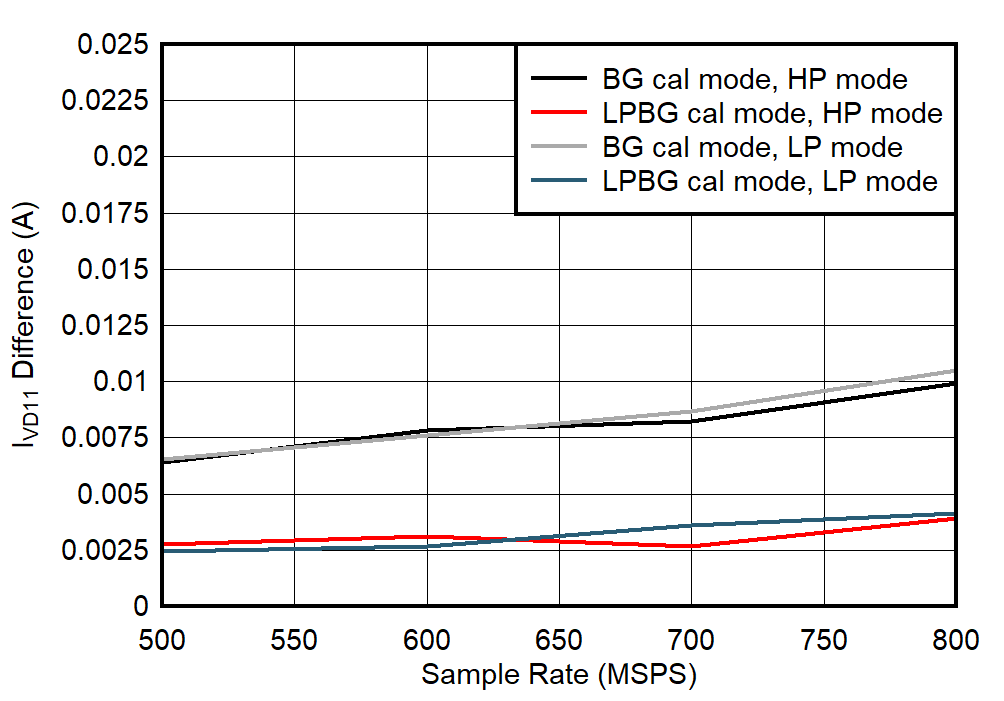
| Independent of Power Mode |
Figure 5-111 Dual
Channel, IVD11 Change with Calibration Mode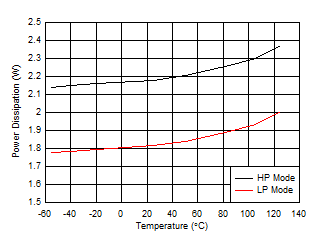
| Independent of Power Mode |
Figure 5-113 Quad
Channel, Power Dissipation vs Temperature
| Independent of Power Mode |
Figure 5-115 Single Channel, Power Dissipation vs Temperature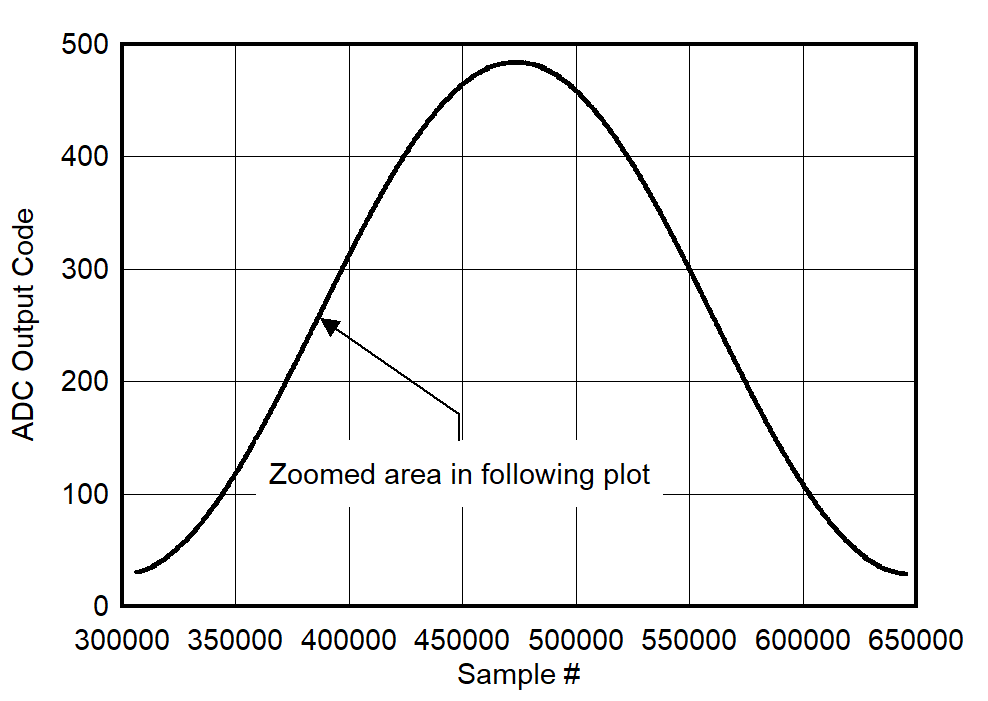 Figure 5-117 Background Core Transition (AC Signal)
Figure 5-117 Background Core Transition (AC Signal) Figure 5-2 INL
vs Code
Figure 5-2 INL
vs Code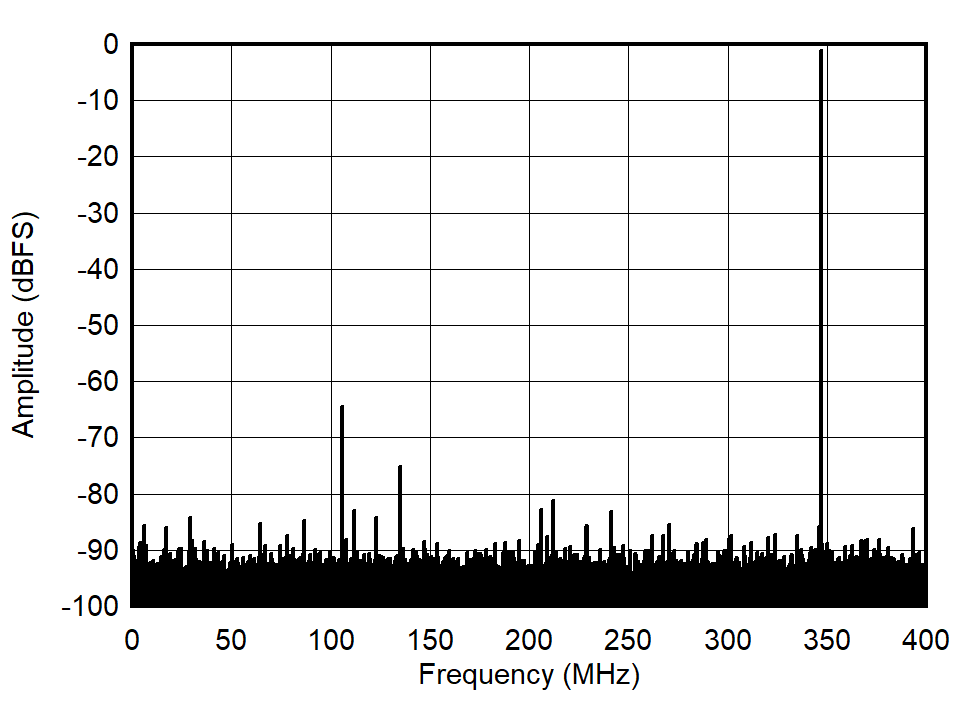 Figure 5-4 Single Tone FFT at 347 MHz and -1dBFS
Figure 5-4 Single Tone FFT at 347 MHz and -1dBFS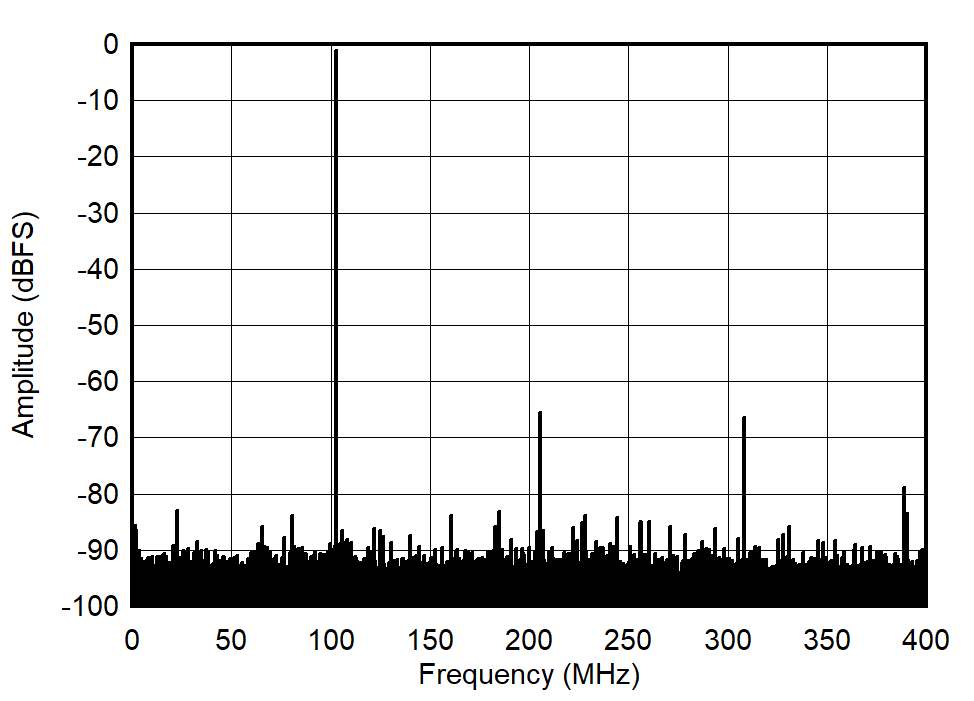 Figure 5-6 Single Tone FFT at 1497 MHz and -1dBFS
Figure 5-6 Single Tone FFT at 1497 MHz and -1dBFS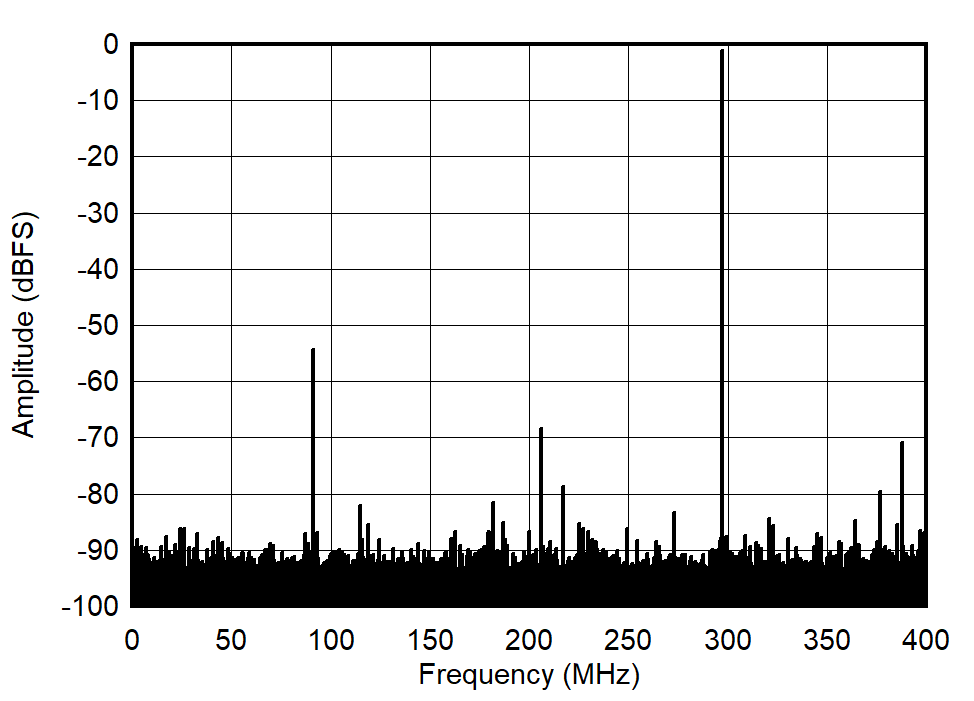 Figure 5-8 Single Tone FFT at 2697 MHz and -1dBFS
Figure 5-8 Single Tone FFT at 2697 MHz and -1dBFS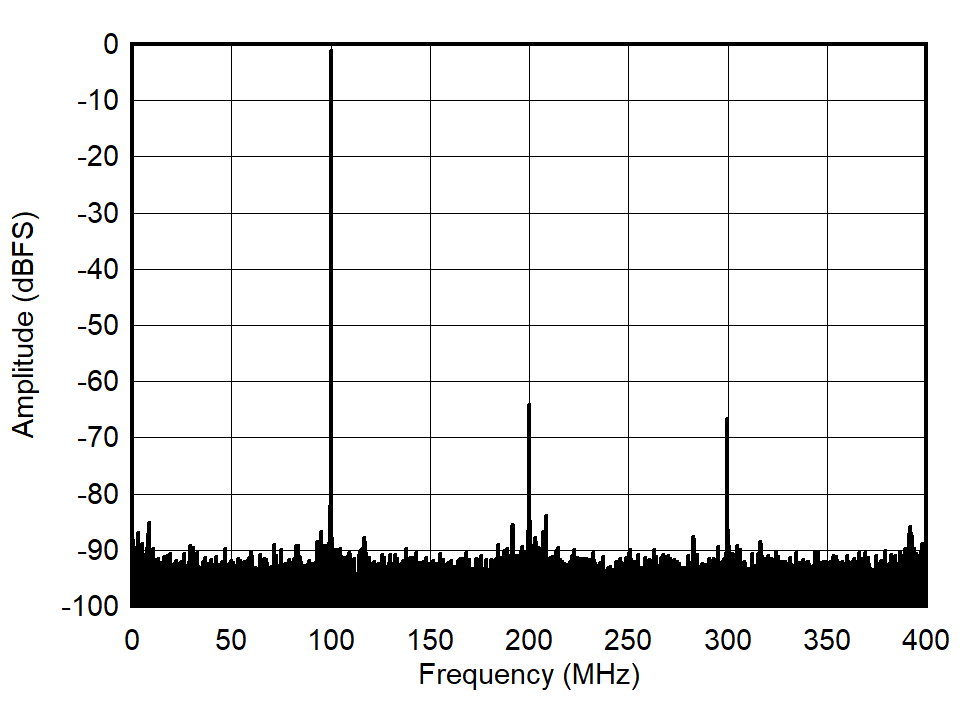 Figure 5-10 Single Tone FFT at 100MHz and -1dBFS
Figure 5-10 Single Tone FFT at 100MHz and -1dBFS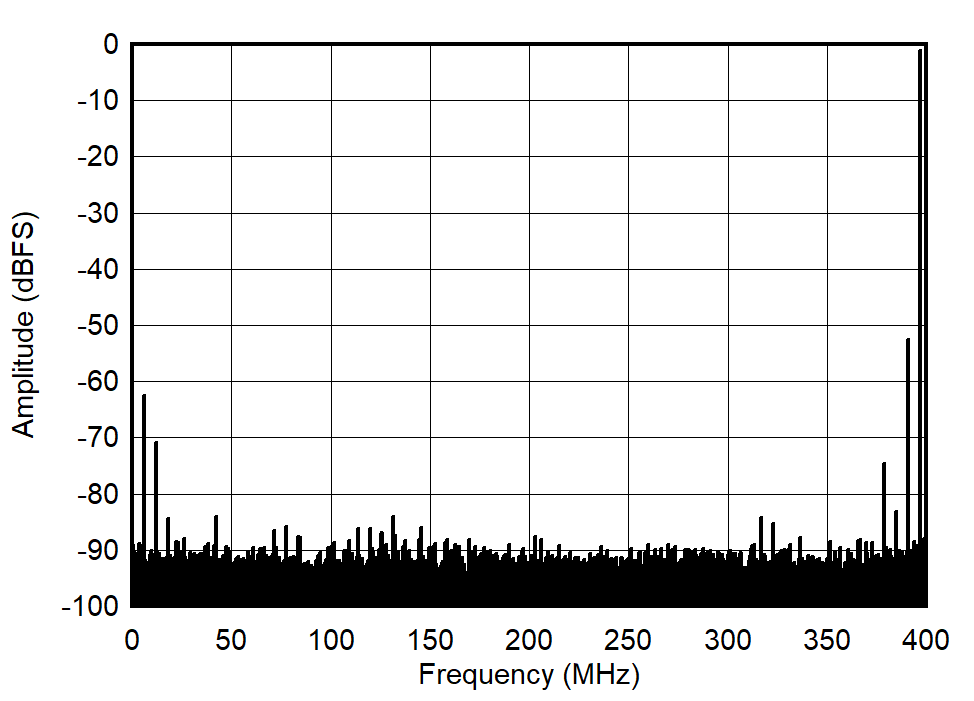 Figure 5-12 Single Tone FFT at 1197MHz and -1dBFS
Figure 5-12 Single Tone FFT at 1197MHz and -1dBFS Figure 5-14 SFDR
vs Input Frequency
Figure 5-14 SFDR
vs Input Frequency Figure 5-16 SINAD
vs Input Frequency
Figure 5-16 SINAD
vs Input Frequency Figure 5-18 HD2
vs Input Frequency
Figure 5-18 HD2
vs Input Frequency Figure 5-20 SFDR
vs Sample Rate
Figure 5-20 SFDR
vs Sample Rate Figure 5-22 SINAD
vs Sample Rate
Figure 5-22 SINAD
vs Sample Rate Figure 5-24 SFDR
vs Sample Rate
Figure 5-24 SFDR
vs Sample Rate Figure 5-26 SINAD
vs Sample Rate
Figure 5-26 SINAD
vs Sample Rate Figure 5-28 SFDR
vs Input Amplitude
Figure 5-28 SFDR
vs Input Amplitude Figure 5-30 SFDR
vs Input Amplitude
Figure 5-30 SFDR
vs Input Amplitude Figure 5-32 SNR
vs Clock Amplitude
Figure 5-32 SNR
vs Clock Amplitude Figure 5-34 SNR
vs Temperature
Figure 5-34 SNR
vs Temperature Figure 5-36 SINAD
vs Temperature
Figure 5-36 SINAD
vs Temperature Figure 5-38 HD3
vs Temperature
Figure 5-38 HD3
vs Temperature
| Low
Power Mode, FIN = 347MHz |
Figure 5-40 SNR
vs Temperature
| Low
Power Mode, FIN = 347MHz |
Figure 5-42 SINAD
vs Temperature
| Low
Power Mode, FIN = 347MHz |
Figure 5-44 HD3
vs Temperature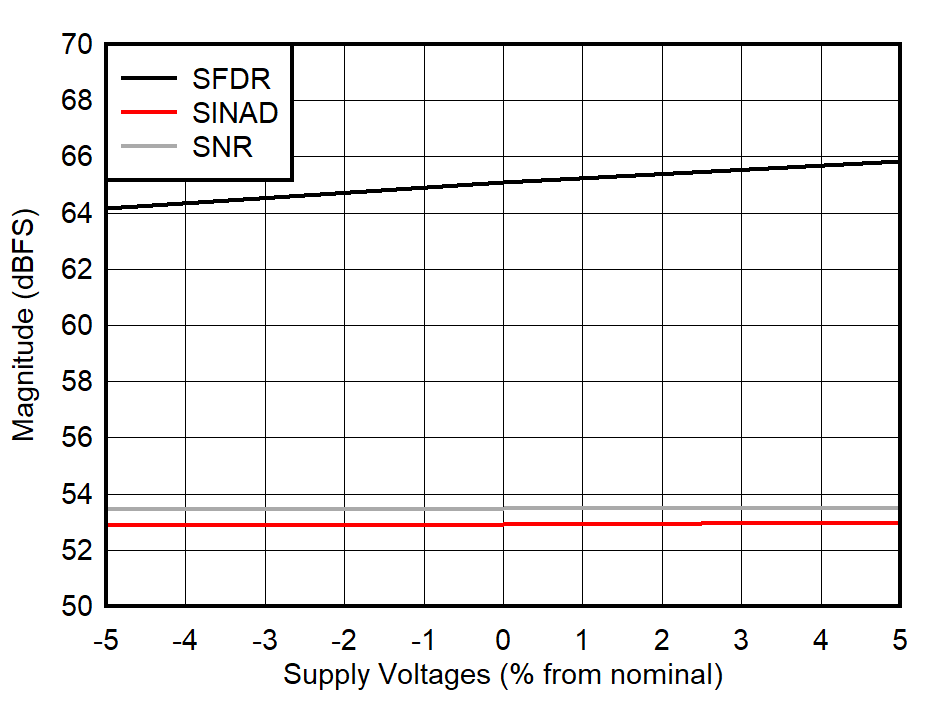 Figure 5-46 SNR,
SFDR and SINAD vs Supply Voltage
Figure 5-46 SNR,
SFDR and SINAD vs Supply Voltage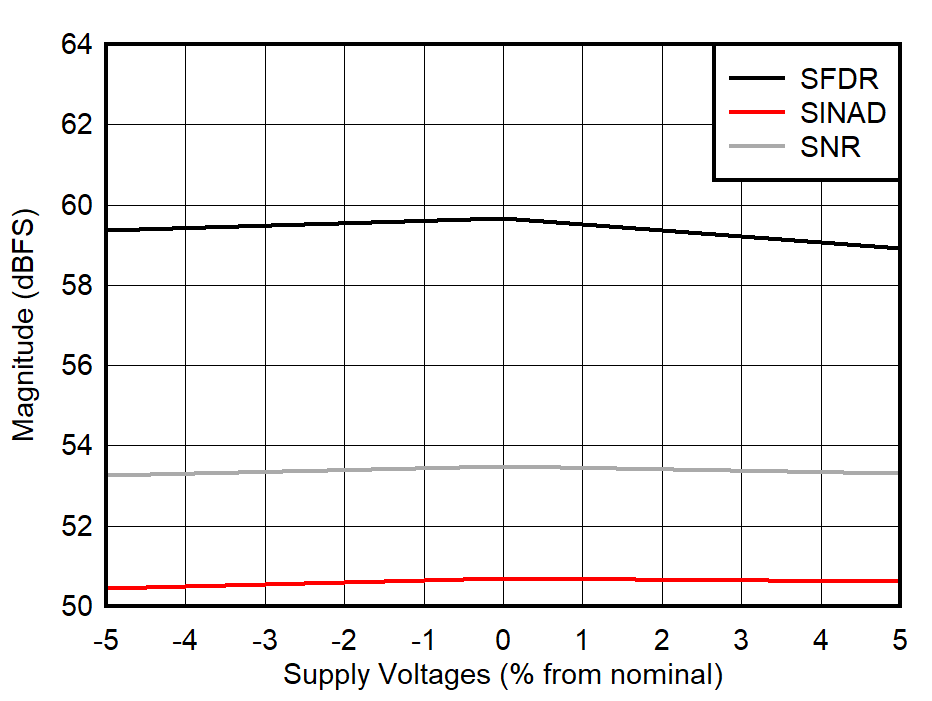
| Low
Power Mode, FIN = 347MHz |
Figure 5-48 SNR,
SFDR and SINAD vs Supply Voltage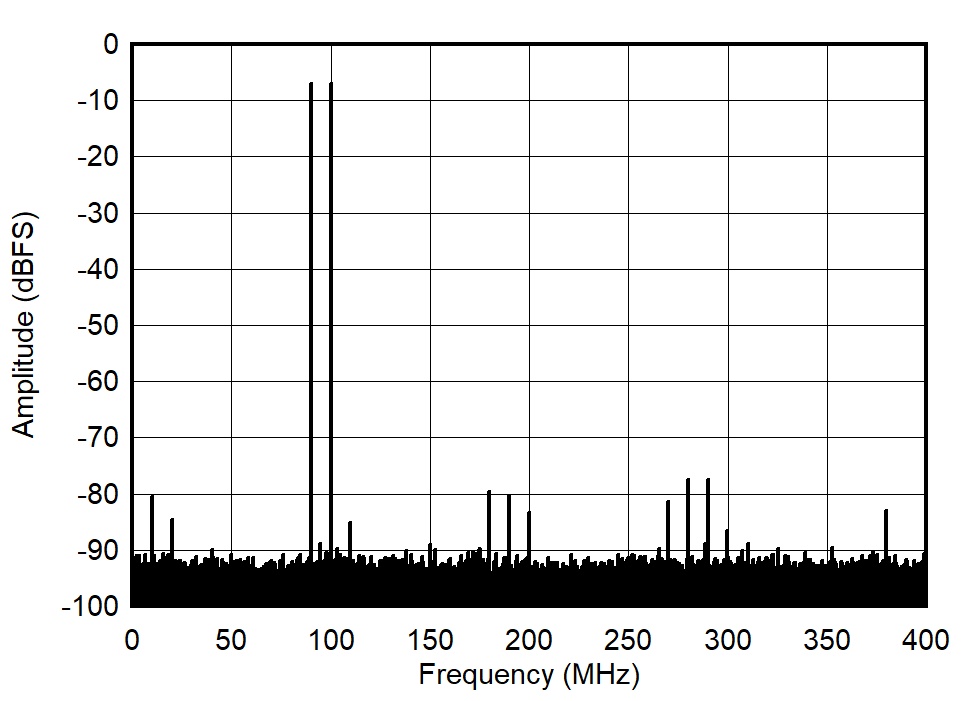 Figure 5-50 Single Tone FFT at 95 MHz
Figure 5-50 Single Tone FFT at 95 MHz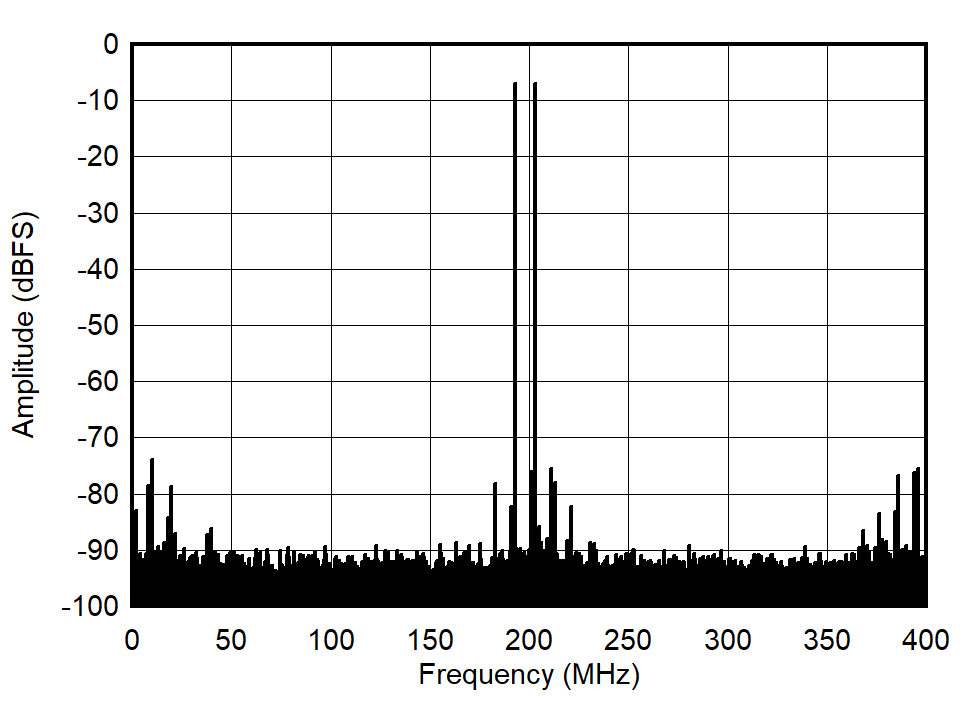 Figure 5-52 Single Tone FFT at 998 MHz
Figure 5-52 Single Tone FFT at 998 MHz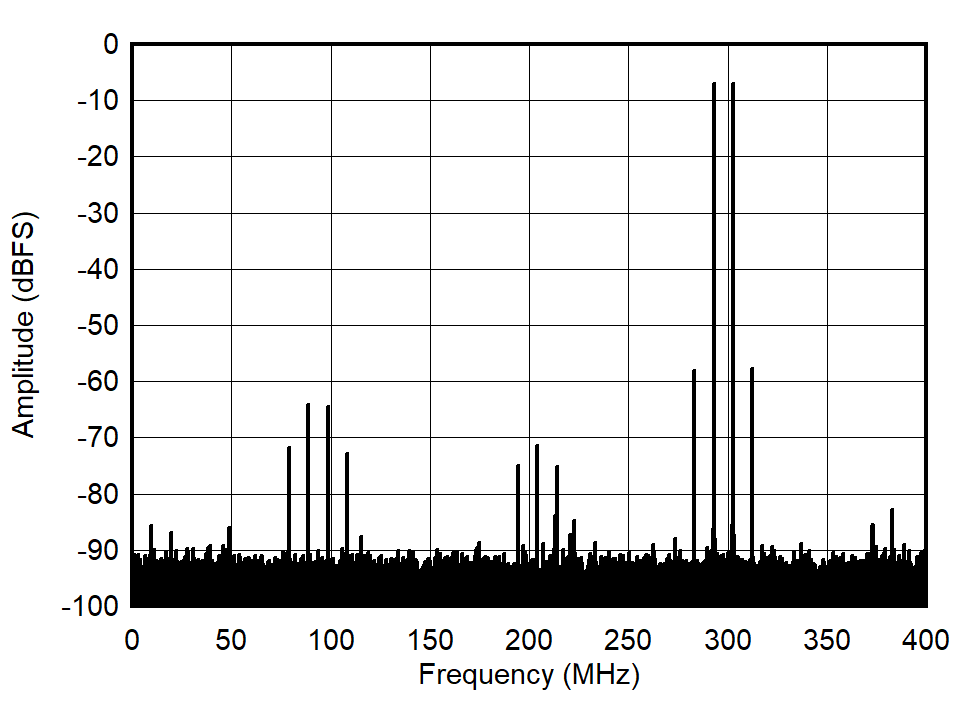 Figure 5-54 Single Tone FFT at 2698 MHz
Figure 5-54 Single Tone FFT at 2698 MHz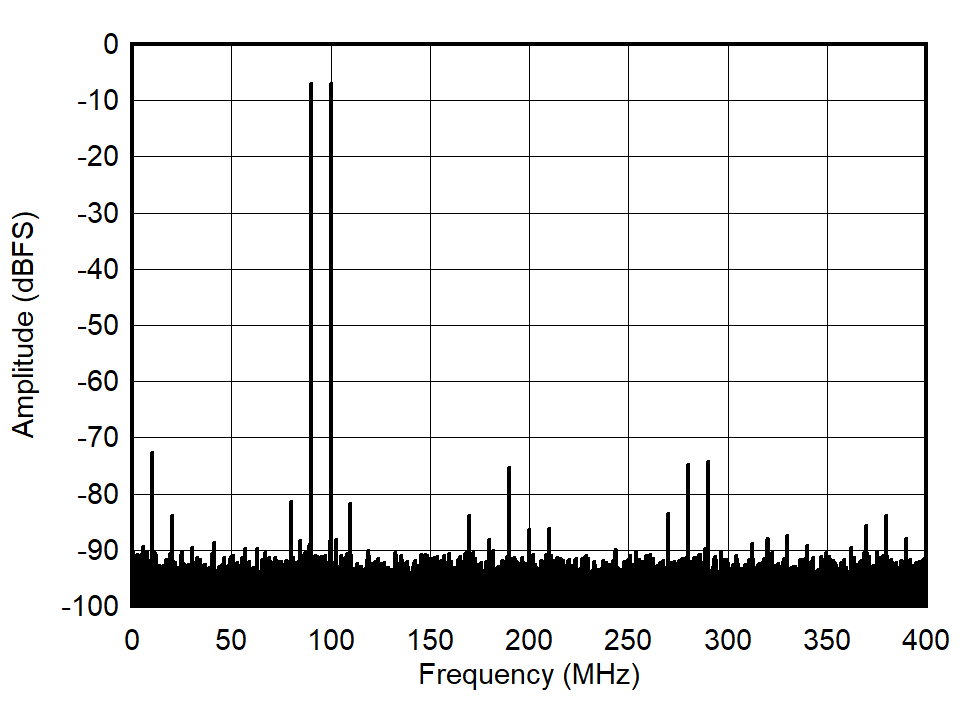
| Low
Power Mode, -7 dBFS each tone |
Figure 5-56 Single Tone FFT at 95 MHz (LP Mode)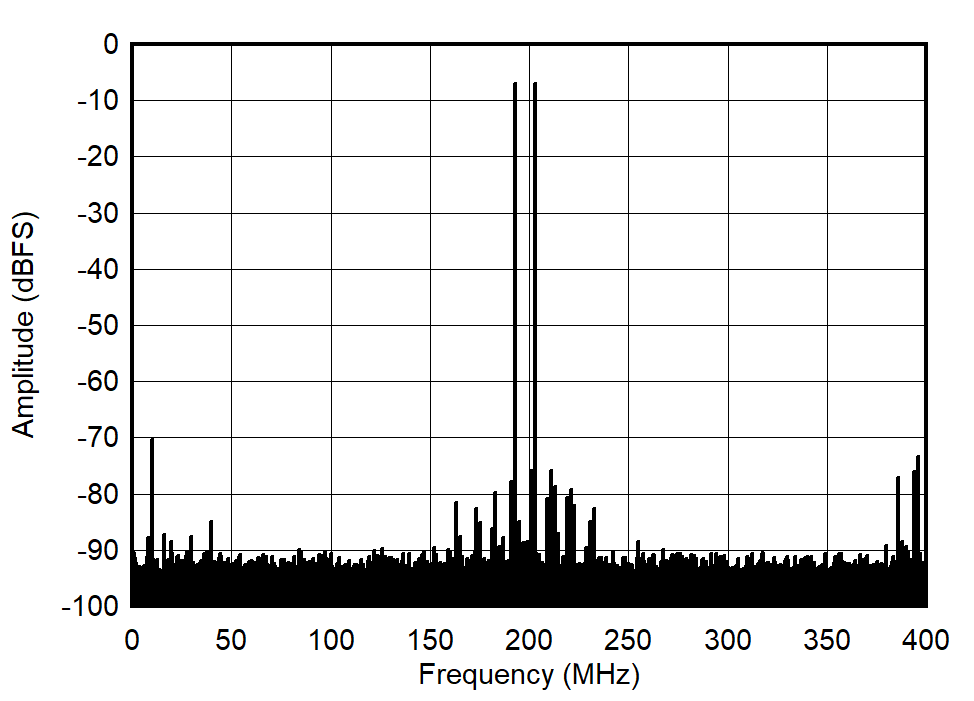
| Low
Power Mode, -7 dBFS each tone |
Figure 5-58 Single Tone FFT at 998 MHz (LP Mode)
| Low
Power Mode, 10 MHz Tone Spacing |
Figure 5-60 IMD3
vs Input Frequency (LP Mode) Figure 5-62 Crosstalk vs Input Frequency
Figure 5-62 Crosstalk vs Input Frequency Figure 5-64 SFDR
vs Reference Clock Frequency
Figure 5-64 SFDR
vs Reference Clock Frequency Figure 5-66 SNR
vs Input Frequency and CPLL and Power Mode
Figure 5-66 SNR
vs Input Frequency and CPLL and Power Mode Figure 5-68 ENOB
vs Input Frequency and CPLL and Power Mode
Figure 5-68 ENOB
vs Input Frequency and CPLL and Power Mode Figure 5-70 HD3
vs Input Frequency and CPLL and Power Mode
Figure 5-70 HD3
vs Input Frequency and CPLL and Power Mode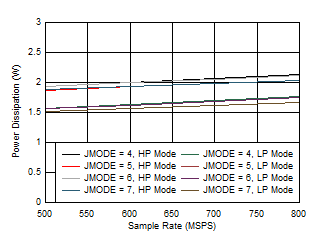 Figure 5-72 Quad
Channel, Power Dissipation vs FS for JMODES 4 - 7
Figure 5-72 Quad
Channel, Power Dissipation vs FS for JMODES 4 - 7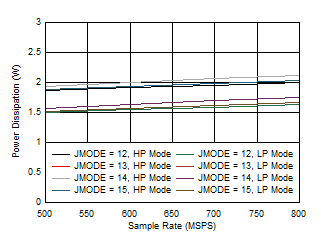 Figure 5-74 Quad
Channel, Power Dissipation vs FS for JMODES 12 - 15
Figure 5-74 Quad
Channel, Power Dissipation vs FS for JMODES 12 - 15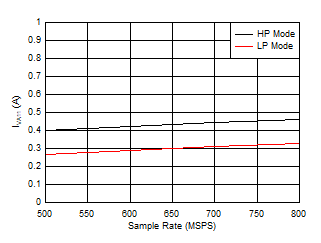 Figure 5-76 Quad
Channel, IVA11 vs FS
Figure 5-76 Quad
Channel, IVA11 vs FS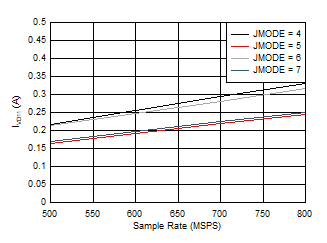
| Independent of Power Mode |
Figure 5-78 Quad
Channel, IVD11 vs FS for JMODES 4 - 7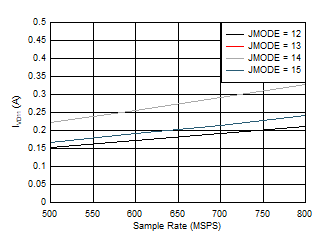
| Independent of Power Mode |
Figure 5-80 Quad
Channel, IVD11 vs FS for JMODES 12 - 15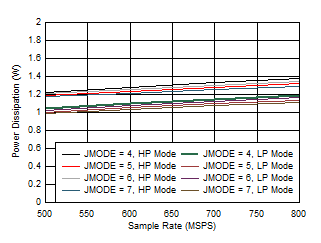 Figure 5-82 Dual
Channel, Power Dissipation vs FS for JMODES 4 - 7
Figure 5-82 Dual
Channel, Power Dissipation vs FS for JMODES 4 - 7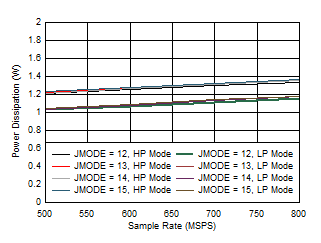 Figure 5-84 Dual
Channel, Power Dissipation vs FS for JMODES 12 - 15
Figure 5-84 Dual
Channel, Power Dissipation vs FS for JMODES 12 - 15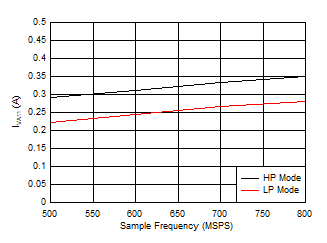 Figure 5-86 Dual
Channel, IVA11 vs FS
Figure 5-86 Dual
Channel, IVA11 vs FS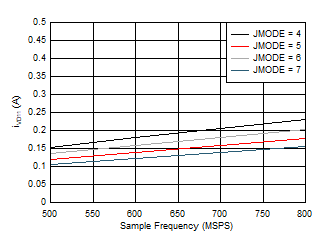
| Independent of Power Mode |
Figure 5-88 Dual
Channel, IVD11 vs FS for JMODES 4 - 7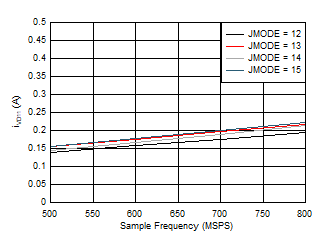
| Independent of Power Mode |
Figure 5-90 Dual
Channel, IVD11 vs FS for JMODES 12 - 15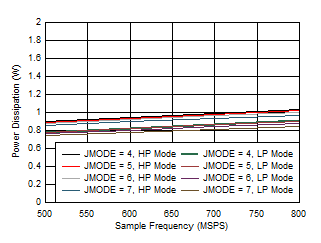 Figure 5-92 Single Channel, Power Dissipation vs FS for JMODES 4 - 7
Figure 5-92 Single Channel, Power Dissipation vs FS for JMODES 4 - 7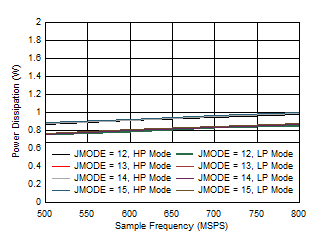 Figure 5-94 Single Channel, Power Dissipation vs FS for JMODES 12 -
15
Figure 5-94 Single Channel, Power Dissipation vs FS for JMODES 12 -
15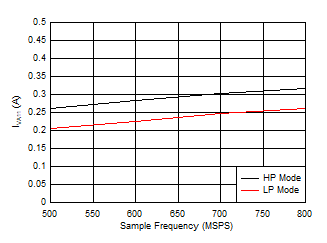 Figure 5-96 Single Channel, IVA11 vs FS
Figure 5-96 Single Channel, IVA11 vs FS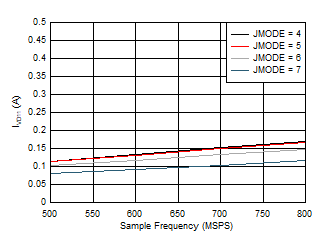
| Independent of Power Mode |
Figure 5-98 Single Channel, IVD11 vs FS for JMODES 4 - 7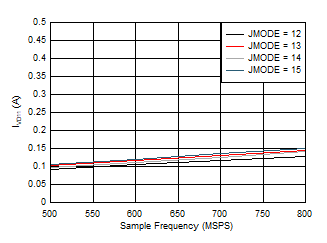
| Independent of Power Mode |
Figure 5-100 Single Channel, IVD11 vs FS for JMODES 12 -
15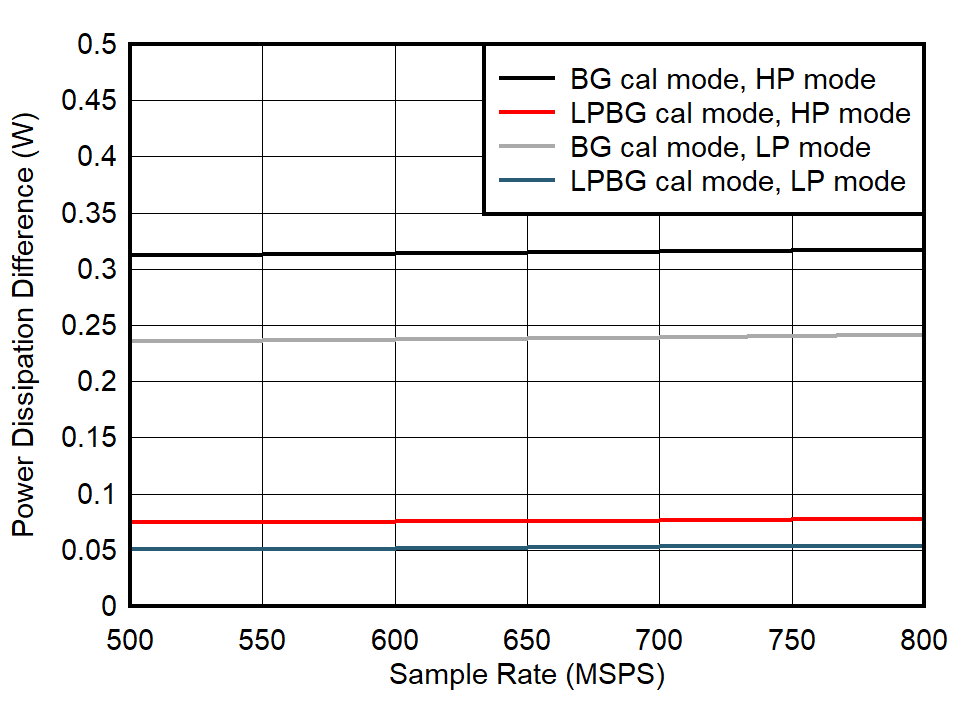
| Independent of Power Mode |
Figure 5-102 Dual
Channel, Power Dissipation Change with Calibration Mode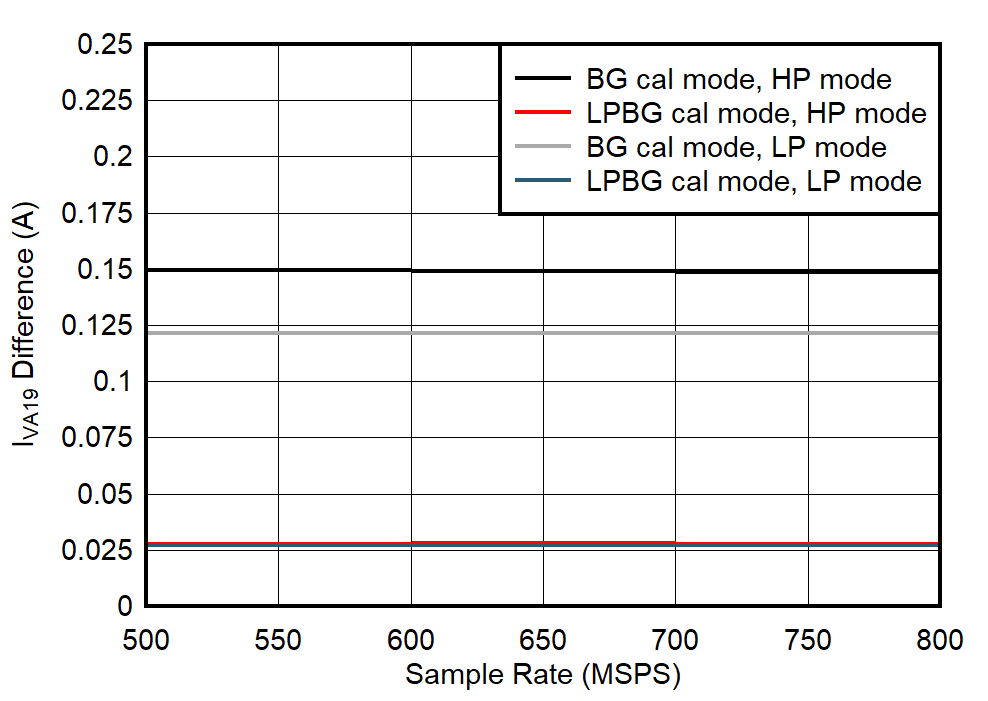
| Independent of Power Mode |
Figure 5-104 Quad
Channel, IVA19 Change with Calibration Mode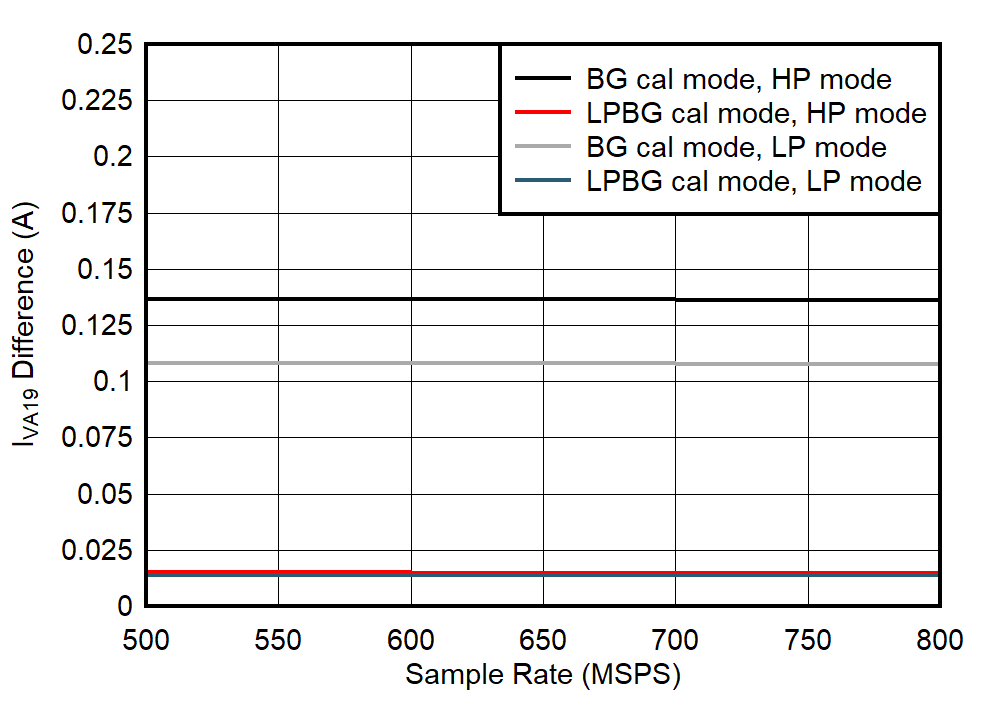
| Independent of Power Mode |
Figure 5-106 Single Channel, IVA19 Change with Calibration Mode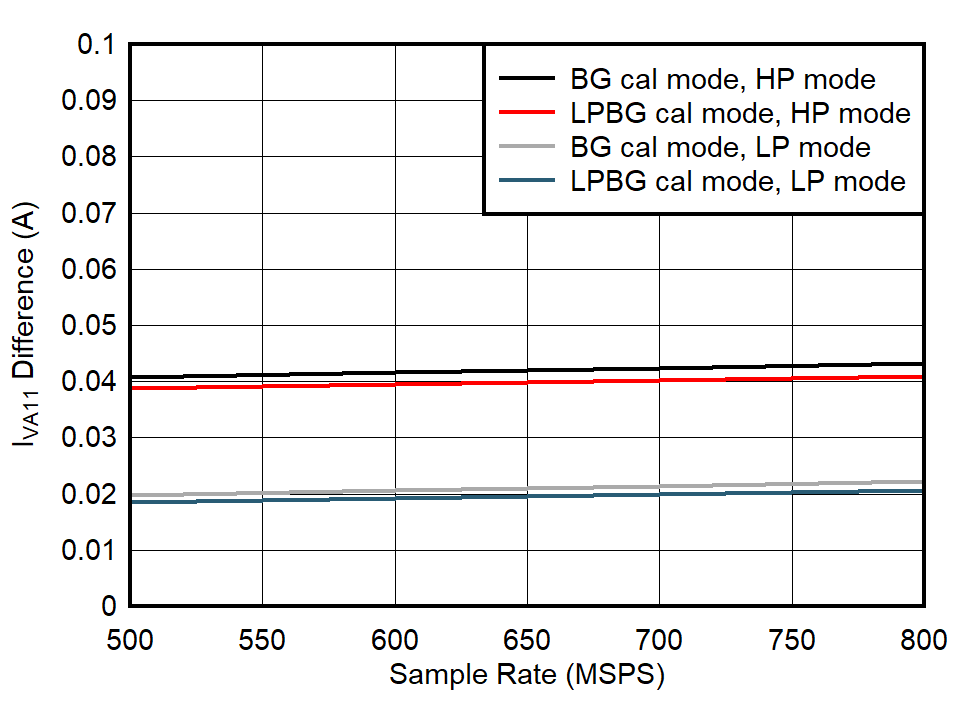
| Independent of Power Mode |
Figure 5-108 Dual
Channel, IVA11 Change with Calibration Mode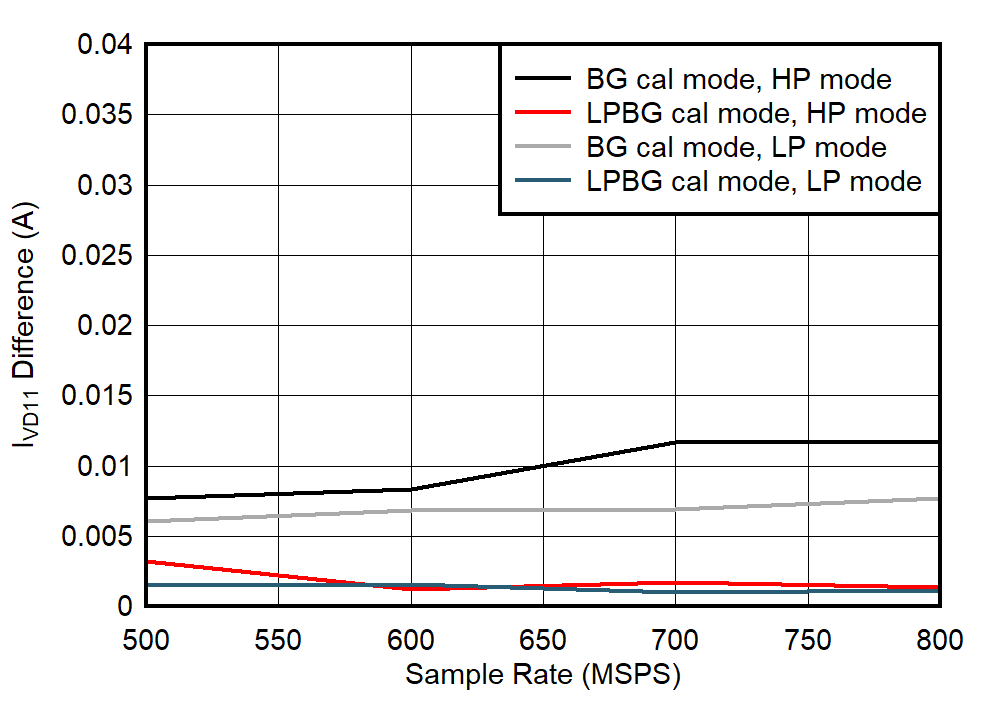
| Independent of Power Mode |
Figure 5-110 Quad
Channel, IVD11 Change with Calibration Mode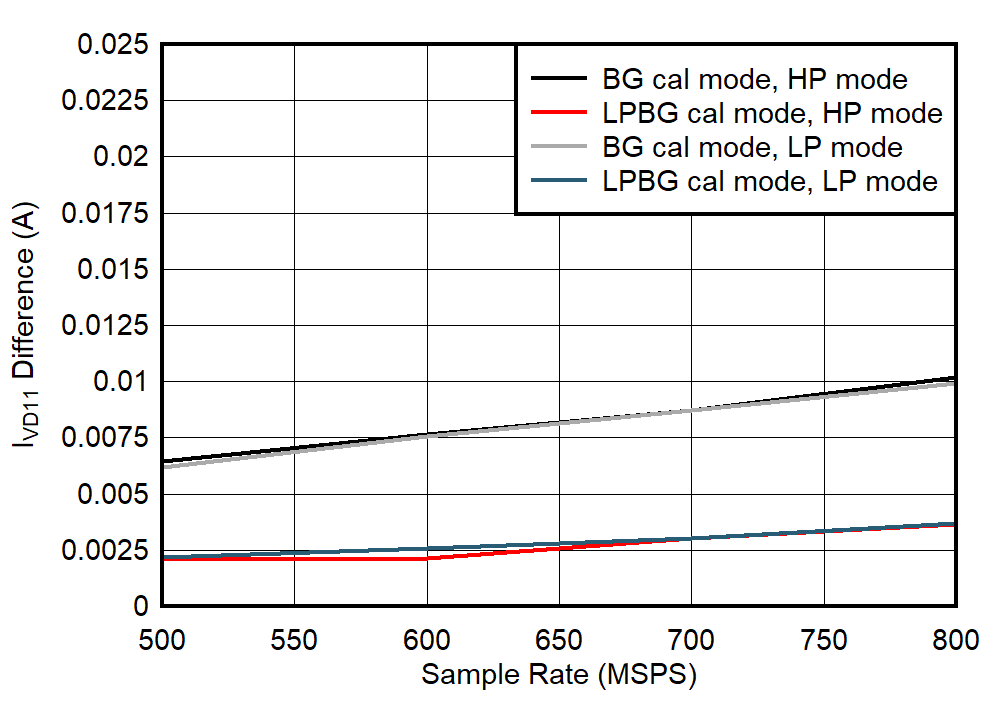
| Independent of Power Mode |
Figure 5-112 Single Channel, IVD11 Change with Calibration Mode
| Independent of Power Mode |
Figure 5-114 Dual
Channel, Power Dissipation vs Temperature Figure 5-116 Background Core Transition (DC midscale input)
Figure 5-116 Background Core Transition (DC midscale input)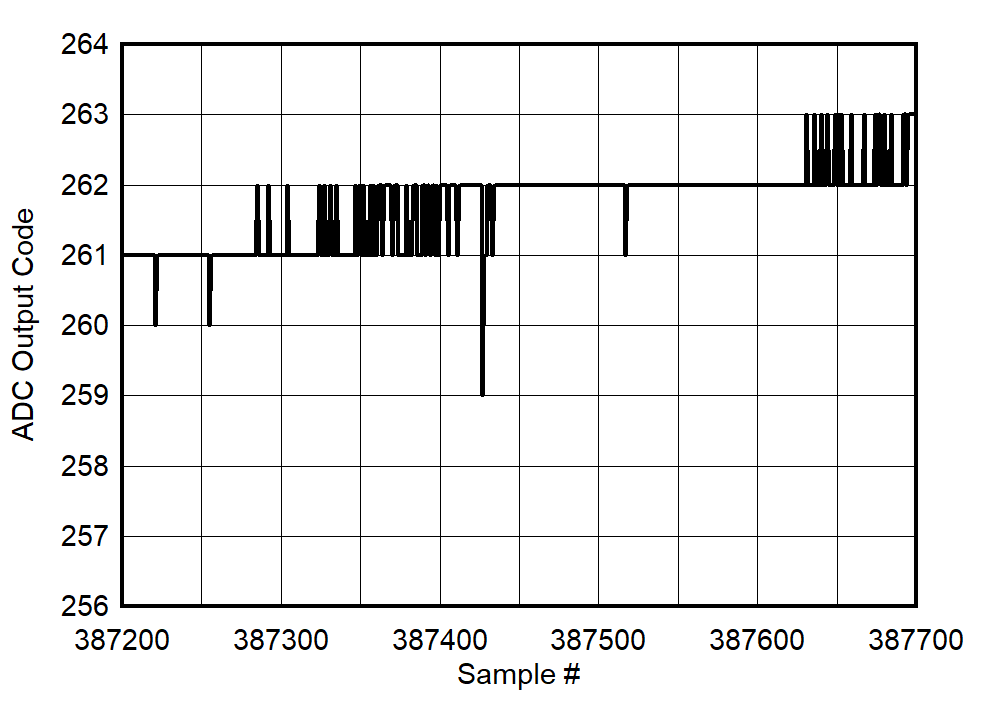 Figure 5-118 Background Core Transition (AC Signal Zoomed)
Figure 5-118 Background Core Transition (AC Signal Zoomed)





















































































































